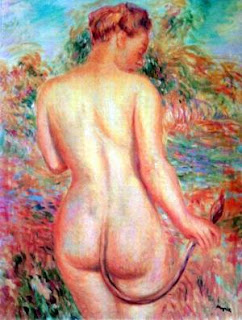The next piece of art we'll be taking a look at is more of a tone piece. This is "In The Dull Village" by David Hockney:
 |
| "In The Dull Village" - 1966 |
The first thing to note about this etching is that it is based on "In The Dreary Village" by Greek poet Constantine Cavafy. The poem has several different translations, all of which are inanely difficult to locate, but the story is more or less the same in each one:
In a dreary, destitute, dull village
far beyond the back of beyond
(so it seems to him)
a handsome young man
is store assistant.
He's longing to get to the bright lights
(such they appear, viewed from the squalor here)
of the nearest glowing city,
music and dancing and song.
For now, he waits for trade to slacken off
in two or three months it's bound to happen
Then he can escape.
Meantime in the dreary village
asleep in his single bed
after hot hours of longing and regret
there comes to him in all its beautiful sparkle
the hallowed shape of satisfied desire.
In the etching, we see two men, naked from the waist up, laying in bed together. One man looks relaxed, perhaps sleeping with his hands behind his head. The surprise on the face of the man next to him suggests that this etching is an interpretation of the final stanza of the poem.
Both the poem and the etching depict, above anything else, a sense of boredom and complacency. The poem does so by textually expressing a longing for something more, and having that longing manifest itself in some uncertain form. The etching depicts this tone more in the framing, style, and placement of everything.
Note the outlines: thin, very non-obtrusive. This gives the whole thing a very downplayed feel. The angle at which the audience views the scene taking place is very flat and unassuming. The biggest break from this uniformity is the sleeping man on the left. His bold, dark body hair, not to mention the large black shape above his head certainly draw attention to him and place him squarely outside the reality of the rest of the etching. His bedfellow, too, seems incapable of believing his presence. Add to it, the sheer number of differences in the appearance of the two men: The sleeping man is hairy, and has a mustache, and short, dark, combed hair; the other man is hairless, clean-shaven, and has longer, messy blond hair.
Since the poem indicates in the "handsome young man" a desire for the city life to break from the dull monotony of the village life, it only makes sense that the "hallowed shape of satisfied desire" would be represented by someone completely anterior to himself.
As for Hockney's decision to depict two men, rather than a man and a woman: the boy in the poem longs for the life of hedonism found in the city, indulging in one's innermost desires. It would not be much of a stretch to believe that a young man in such a dull, repressive village as the one depicted would have unexplored homosexual tendencies, for which he feels the city would be a suitable outlet. Not to mention the fact that Cavafy was one of the first poets to write about homosexuality.
My Opinion
I don't like this piece as much as I am intrigued by it. Usually when there are works that exist in multiple mediums to tell different parts of a cohesive story, I become fascinated. Obviously, since art is a subjective medium, there is no way of knowing every possible detail between the two interconnected pieces, and this just sends my brain into a euphoria of deduction. I always have to try and fill in what's missing, I want to be the one to figure it out, and I feel like there are unsolved mysteries between these two works. I can't say for sure why, but there's just something about them...
Well, that's all for now! Hope you stop by next time!














